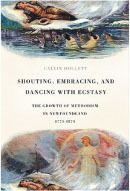Methodist revival in 1800s Newfoundland
I
n 1816, the lion’s share of Newfoundland’s 53,000 inhabitants lived in St. John’s and the rest of the Avalon Peninsula in the southeast corner of the island. Most of the rest made their homes in the smaller outports along the northeast and southern coasts.
The religious loyalties of the people reflected their largely English and Irish origins. One in three belonged to the Catholic Church and the rest were mainly Anglicans. But a third religious current was growing among Newfoundlanders – Methodism.
Originally a renewal movement within Anglicanism sparked by the evangelist John Wesley, Methodism emphasized the importance of conversion, fervent personal faith, accountable discipleship in small groups called classes and the preaching of the gospel to the masses.
Methodism came to Newfoundland with the Irish-born Laurence Coughlan, a strange figure. By the time he arrived in Newfoundland in 1766, Coughlan had lost the trust of Wesley due to his odd conduct, but convinced the authorities to appoint him an Anglican missionary in the Conception Bay area.
At the time, Methodism was not yet clearly distinct from Anglicanism and Coughlan’s real passion was spreading Wesley’s revival movement among his flock. This passion – not to mention his tendency to denounce influential parishioners for adultery and Sabbath breaking – provoked opposition and conflict, and Coughlan left for England in 1773, never to return.

Mary Anne Pelley’s public prayer for fish left a legacy in Hant’s Harbour.
Yet Coughlan’s departure was not the end of Methodism in Newfoundland. Older historical accounts focused on the role of missionaries like Coughlan and the ones who came from England after 1815. But in his book Shouting, Embracing, and Dancing with Ecstasy: The Growth of Methodism in Newfoundland 1774–1874 (McGill-Queen’s, 2010), historian Calvin Hollett shows Methodism continued to spread and thrive because of the activities of devout laypeople.
Particularly in the remote outports, where missionaries were few and far between, it was converted laypeople who led class meetings and whose voices were prominent in services in public prayer, and exhorting their brothers and sisters. Women could not serve as ministers, but nevertheless played a key role as class leaders, exhorted others and even preached on occasion. When there were no fish at Hant’s Harbour in 1868 – a serious problem – people believed it was the powerful public prayer of Mary Anne Pelley, known as Sister Lydia, that God answered with the arrival of the fish.
Laypeople also spread the revival to regions that rarely, if ever, saw a missionary. In the spring of 1859, for example, men from other regions who had been hunting seals had to take shelter in Catalina harbour on the east coast due to bad winds. Catalina had previously resisted the efforts of the Methodist missionary. But these sealers had been powerfully affected by revivals in their own homes that winter, and it was their exhortations and prayers that brought revival to Catalina as well.
Like evangelical revival movements elsewhere, Methodism in Newfoundland profoundly transformed the people touched by it. It brought deep conviction of sin and a turn to God in repentance and faith, followed by great joy and a desire to proclaim God’s mercy to others. It also promoted holy living – drunkenness declined and Sabbath observance increased in regions affected by Methodist revival.
In a land where the power of the sea and the fickleness of the catch were ever-present dangers, Methodism also encouraged an attitude of trust in God’s purposes and provision, even in times of loss and suffering.
The recollections of John Waterhouse of missionary meetings at Blackhead, near the very easternmost tip of North America, sum up the spirit of revival:
They were times when the hearts of the brethren overflowed; when old memories were revived; when anecdote and repartee, and songs of praise to God, were the order of the day. … Small companies of men and women came trooping over the hills from Adam’s Cove, and others from the direction of Mulley’s Cove. On they came in scores and hundreds.
What an exciting time! How the power, and the joy, and the glory of the Spirit of Christ streamed and flooded, and swept all around.… The old church was packed! Extra beams and props were placed under the galleries. It was a sight for angels.
Kevin Flatt is professor of history at Redeemer University in Ancaster, Ont. Read more at www.FaithToday.ca/HistoryLesson.